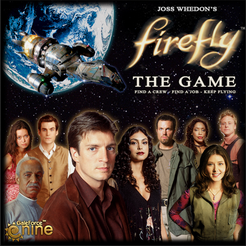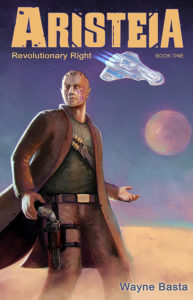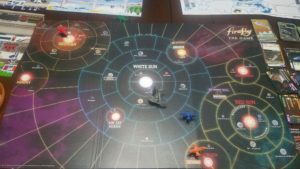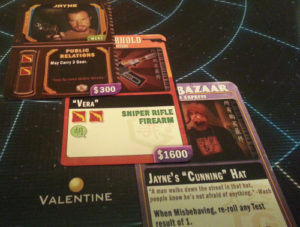
Take my love, take my land,
Take me where I cannot stand.
I don’t care, I’m still free,
You can’t take the sky from me.
-Joss Whedon
Like many, I never saw Firefly when it was originally on television. A few years after it went off air, Sci-fi (or was it already SyFy then?) ran the series, in order, just before the Serenity movie came out. I had heard many great things about the series. I wasn’t completely sold until the very end of the first episode. From there I was hooked. I became one of the many late fans that wondered why the show never got a second season.
 Firefly has gone on to heavily influence me. You can see it in my writing. A reader once told me she saw the cover of my first book from across a book fair and immediately thought of Captain Mal. I hadn’t realized the cover art comparison until then. It has gone on to influence my gaming. When I play RPG’s or computer games I’m always trying to get the small group feel of the crew of Serenity. That essence is not unique to Firefly but it has a pretty distinctive flavor of it. It has even influenced my take on other media. I fell in love with Star Wars: Rebels in no small part because of the Fireflyish feel of the Ghost crew.
Firefly has gone on to heavily influence me. You can see it in my writing. A reader once told me she saw the cover of my first book from across a book fair and immediately thought of Captain Mal. I hadn’t realized the cover art comparison until then. It has gone on to influence my gaming. When I play RPG’s or computer games I’m always trying to get the small group feel of the crew of Serenity. That essence is not unique to Firefly but it has a pretty distinctive flavor of it. It has even influenced my take on other media. I fell in love with Star Wars: Rebels in no small part because of the Fireflyish feel of the Ghost crew.
All that said I’m miles away from a hardcore Browncoat. I’ve never cosplayed, read any of the comics or played the RPG. But I did pick up the board game a little while back. And that’s what I’m going to review today.
Production- B+
 The game comes with several small plastic space ship models. The pieces are reasonably detailed though are all just a single color. You get an Alliance Cruiser, Reaver cutter and several Firefly class player ships. The Alliance ship, due to the nature of its tall spires, is not particularly sturdy. One of the spires broke off almost immediately. But that said, they are all pretty nice for what you get.
The game comes with several small plastic space ship models. The pieces are reasonably detailed though are all just a single color. You get an Alliance Cruiser, Reaver cutter and several Firefly class player ships. The Alliance ship, due to the nature of its tall spires, is not particularly sturdy. One of the spires broke off almost immediately. But that said, they are all pretty nice for what you get.
The game also includes some of the best game money I’ve ever seen. You get a thick stack of money in multiple denominations that are modeled after the money used in the show. And I do mean thick. These bills are not your flimsy Monopoly dollars. Each one feels like it could be genuine currency. These are really quite well done.
The board is sturdy and distinctive. You really gain an understanding of what the ‘Verse is like with the vast empty space between interconnected solar systems. It does point out how ridiculous the concept is, a solar system with far more stars in close orbits of each other than we’ve ever seen. I’m a fan but I can’t exactly say this universe is any more realistic than a world with warp drive.
Overall, the material you get with the game is top notch.
Theme- A+
The game really shines in its ability to capture the feel of Firefly. The core gameplay involves struggling to stay afloat, gathering a crew to help you and avoid any Alliance entanglements. Everything about the game revolves around the feel of the show, sometimes to its detriment, but we’ll cover that later.
 You start out with a ship, a little bit of cash and the open sky. From there you decide how to complete your objectives. Along the way, you can stop at many of the locales from the show and pick up missions from colorful characters or go shopping for spiffy upgrades. Shopping is where you pick up new crew along with new gear. All of the Firefly characters are available as crew, except Mal who is one of the captains. Appropriately they are some of the most powerful crew options though not to an unbalanced degree. You can get by just fine recruiting other characters to join you.
You start out with a ship, a little bit of cash and the open sky. From there you decide how to complete your objectives. Along the way, you can stop at many of the locales from the show and pick up missions from colorful characters or go shopping for spiffy upgrades. Shopping is where you pick up new crew along with new gear. All of the Firefly characters are available as crew, except Mal who is one of the captains. Appropriately they are some of the most powerful crew options though not to an unbalanced degree. You can get by just fine recruiting other characters to join you.
The gear itself provides a ton of great themes. You can buy guns, including “Vera.” You can even find Jayne’s hat. Everything, crew and gear, revolves around keywords and these too play into the theme. You can find gear that functions as “Fancy Duds” and some crew, such as Simon, provide this as well. Jayne, being an arsenal in and of himself, can carry three gear when other can normally carry one.
Additionally, much of the gameplay revolves around completing missions and as part of those missions you have to “Aim to Misbehave.” This involves drawing special cards that add complications to your task. The cards set up choices straight out of an episode. In one, you might get into a barfight that you can resolve by winning the fight through combat, or “diplomacy” by threatening to blow a big hole in the little moon. In another, you might have to slip past an Alliance patrol or escape a Reaver attack.
Certain missions can be Immoral or Illegal. Illegal missions are naturally worth more money but run the risk of running afoul of the Alliance. Immoral missions can alienate your crew and demoralize them. Much like in the “Train Job,” there are shades of illegality that some people aren’t willing to cross. If your crew becomes disgruntled they can be easily snatched away by another player or abandon you entirely.
Gameplay- C
Sadly, this is where the wheels begin to come off the game. The goal of each game is dependent on the missions you choose to play. In the core game, there are only a small number of choices. They each fit the game’s theme well and involve you trying to complete a certain objective at certain planets or gather the most money the fastest. How you go about this is up to you but it revolves around completing missions for the aforementioned colorful characters, such as Badger or Niska, to earn money. You spend your money on gear and crew which makes completing your missions easier.
Each turn you get to take two actions from a set of four; move, shop, negotiate, or work. Choosing which action to take when can be a fun element to determining how well you succeed. Do you shop before doing a mission and possibly get some more gear? Or do you attempt to work a mission now so you can get moving to the next planet to stay ahead of the other players?
When you move you can choose to mosey along, moving just a single space. This doesn’t require fuel and is much safer. Alternatively, you can perform a full burn which requires fuel and runs some risks. For each space you move on a full burn you have to draw a card. These cards are thematic, much of the same “Keep Flying” because there isn’t much out there in the black. But a fair number involve some kind of event. These events can be easy, you can choose to perform some salvage and stop or keep going, or they can be hard, aka Reavers attack. The problem with them is the scale of difficulty which we’ll go into more detail about in a moment.
Performing missions, the ones that pay well anyway, require you to draw from the “Aim to Misbehave” deck we mentioned earlier. This is where your crew is tested with skill challenges. There are three types of skills; fighting, repair, and diplomacy. Each Misbehave card gives you two choices on how to complete them, usually involving different skills. The different choices often involve different levels of risk. One might allow you to keep going but if you fail, a crew dies. The other choice might be an easy escape but you fail your attempt at this mission this round.
Many of the Misbehave cards also have a bypass condition. If you have a card with a certain keyword you can just completely pass the card. This is thematically appropriate and jives with the feel of the show; for example having a character with the “Companion” keyword allows you to bypass some trouble just like having Inara allowed the crew to get out of or into many places they wouldn’t normally be able too. Unfortunately, this effect really hurts the gameplay.
These bypass abilities based on keywords end up making the game a race to acquire all the keywords. There are quite a few keywords but not so many it’s not possible to get them all. Once you have them, the game is easy. Misbehaves and movement cards become a guaranteed success. From there all you are doing is biding your time until you have acquired enough money or flown to the correct planets to finish the objective. Sadly, after the first little bit, the game becomes boring.
If the keywords merely provided a bonus to certain cards, like they do sometimes, and very rarely served as a complete bypass it might work better. The difficulty of the different cards is very much out of balance. Early in the game, it is impossible to complete most misbehaves and very damaging on many of the movement cards. But later, they are meaningless. The game does not find the proper balance between those two extremes.
Expansions- Unknown
I have not played with any of the expansions nor investigated them in much detail. They might address this problem. I do know they add new characters, ships, objectives and locations.
Conclusion- B-
If you like Firefly you’ll have fun playing this game a few times just for the sheer thematic nature of it. The game play is harder to fix though.
Wayne Basta
Latest posts by Wayne Basta (see all)
- X-Wing Tier List – Rebels - May 10, 2023
